Oceans and Maritime Pursuits
Tatcho
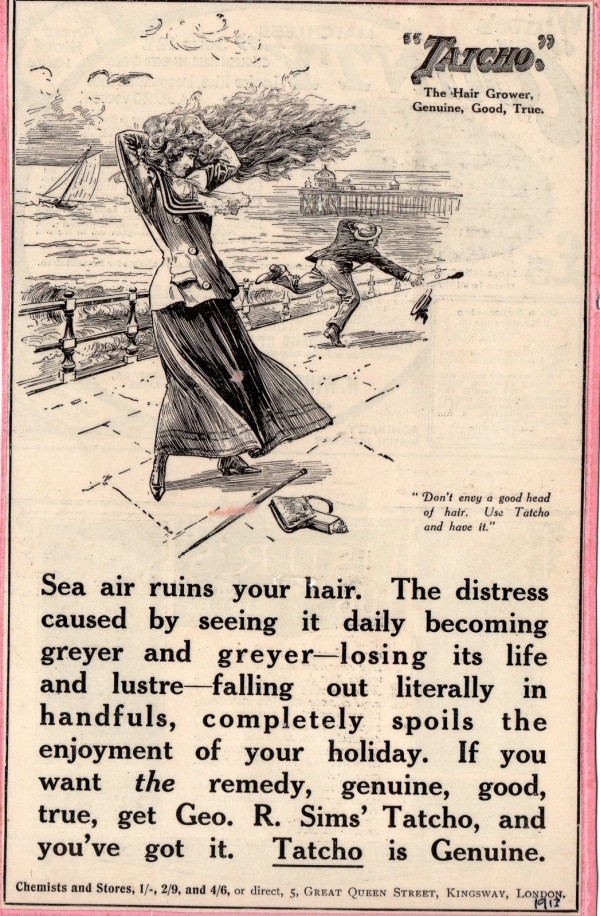
[Click to enlarge]
Who ever knew that a nice day at the beach could cause such horrors?
Explanation of Tatcho.
Posted By: Paul - Mon Dec 22, 2014 -
Comments (4)
Category: Oceans and Maritime Pursuits, Nineteenth Century, Hair and Hairstyling
Olympian Swimmer Ann Curtis Races a Seal
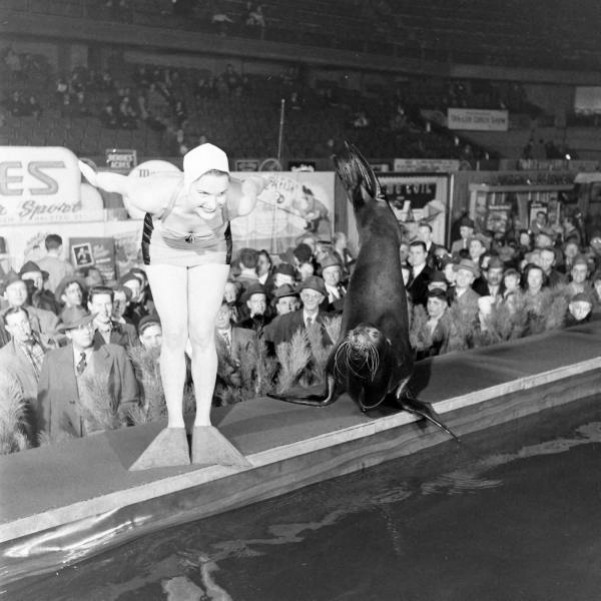
Original article here.
PS: the seal won.
Posted By: Paul - Sat Nov 15, 2014 -
Comments (5)
Category: Animals, Contests, Races and Other Competitions, Oceans and Maritime Pursuits, 1940s
Virgil Partch
I just finished reading this great book on cartoonist Virgil Partch, who defined cartoon weirdness for several decades.The book revealed that Partch was a great joker in real life as well. He and some buddies founded the Balboa Island Sculling and Punting Society, which was an excuse to putter around the marina, freak out the squares and get drunk. Not satisfied with those activities however, they aimed higher. First they decided to take a "boat ride" from their West Coast hangout to Las Vegas. How? By putting a boat on a truck and riding inside the craft while being driven across the desert.
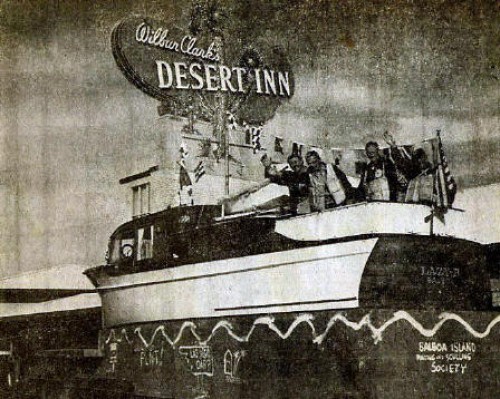
Then they decided to take a train to Catalina Island, by a similar expedient.

Here's a fuller account of their exploits.
Posted By: Paul - Mon May 19, 2014 -
Comments (4)
Category: Oceans and Maritime Pursuits, Comics, Bohemians, Beatniks, Hippies and Slackers, 1950s
By Chevy From Cuba to USA
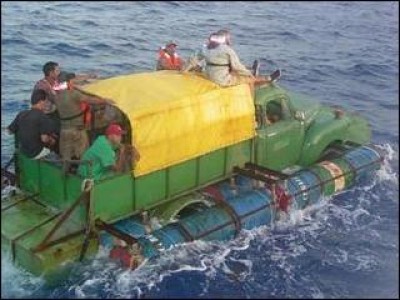
With the recent migrant tragedies at sea around the globe, we must always recall one of the great refugee success stories: turning an old Detroit truck into an ocean-going vessel.
More photos here.
Full story here.
Posted By: Paul - Fri Nov 29, 2013 -
Comments (7)
Category: Dictators, Tyrants and Other Harsh Rulers, Engineering and Construction, Oceans and Maritime Pursuits, North America, Twenty-first Century, Trucks
Doc Owens, Con Man
As early as December 1900, the notorious Doc Owens was making headlines, having established his racket of fleecing sea-going sheep.

READ LEFT-HAND COLUMN, THEN RIGHT-HAND COLUMN, THEN SAME FOR THE TWO FOLLOWING.

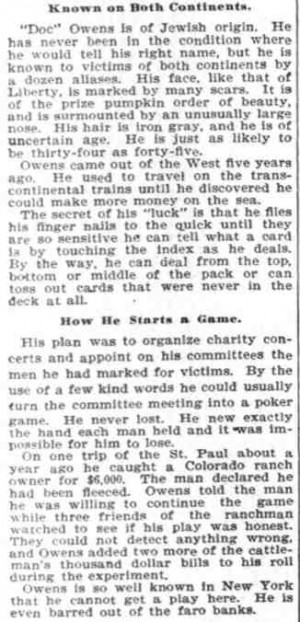
Three years later, The New York Times did a special feature on Owens and his fellows (with his photo miscaptioned).
Click here for very readable PDF download.

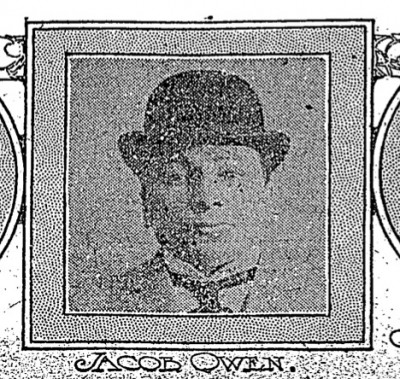
But Owens was to meet poetic justice in 1912, as our final piece reveals.

Posted By: Paul - Fri Feb 15, 2013 -
Comments (2)
Category: Crime, Death, Disasters, Frauds, Cons and Scams, Oceans and Maritime Pursuits, 1900s, 1910s, Gambling, Casinos, Lotteries and Other Games of Chance
Paco Rabanne Bathing Suits: 1966

[Click to enlarge. From Playboy for November 1966.]
Alex has begun a "weird bathing suit" meme, with his WOODEN BATHING SUITS post. I fear I shall have to see him his wood and raise him some plastic.
Posted By: Paul - Sun Dec 16, 2012 -
Comments (9)
Category: Fashion, Oceans and Maritime Pursuits, 1960s
Julia Pott
Belly from Julia Pott on Vimeo.
Posted By: Paul - Thu Dec 13, 2012 -
Comments (0)
Category: Anthropomorphism, Death, Oceans and Maritime Pursuits, Surrealism
Oyster Growing on a Set of False Teeth
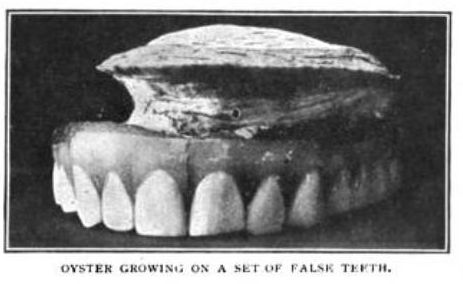
image source: The Strand magazine - 1903
Oysters will grow on almost any surface, including false teeth, if that's what happens to be available. The tooth-growing oyster shown above was found in the Chesapeake Bay in 1898, and sent to the Smithsonian where they were put on display and became quite a popular attraction. But soon a paternity battle erupted around them. The story was told in the Saint Paul Globe (Nov 30, 1902):
And, oddest of all, there is an upper set of false teeth to which an enterprising oyster is firmly attached.
The history of this last oyster is decidedly interesting. About four years ago it was raked out of the waters of Chesapeake bay by a dredging boat, together with the false teeth to which it was firmly fixed, and teeth and oyster were acquired by a hotel keeper at Cowart, Va., whose wife forwarded them to the Smithsonian Institution at Washington. The matter obtaining some advertisement, a man named Webster, residing in Bedford, Iowa, claimed the teeth, saying that he had lost them from a steamer bound for Norfolk.
The Smithsonian officials were undecided at first as to whether they should surrender the teeth or not, the object being so great a curiosity that they were anxious to hold on to it. But not many days later a Philadelphia woman claimed them, asserting that they were hers, and actually a third party, visiting the institution, demanded them, declaring that he recognized them as having been lost by himself.
Probably, from first to last, a good many persons have lost their false teeth overboard in the Chesapeake, the waters of which are liable to be pretty rough at times. Any way, the government scientists did not care to decide the dispute, and concluded to retain the specimen.
Half a century later, in 1954, yet another guy insisted the teeth were his, but in this case the Smithsonian was able to definitively rule out his claim, pointing out that the guy hadn't even been born yet when the teeth were found.
I'm guessing the Smithsonian probably still has this tooth-growing oyster hidden away somewhere in its archives.

Daytona Beach Morning Journal - Jan 28, 1954
Posted By: Alex - Mon Nov 26, 2012 -
Comments (3)
Category: Freaks, Oddities, Quirks of Nature, Museums, Oceans and Maritime Pursuits, Natural Wonders
Noah’s Ark Found—in Alaska!
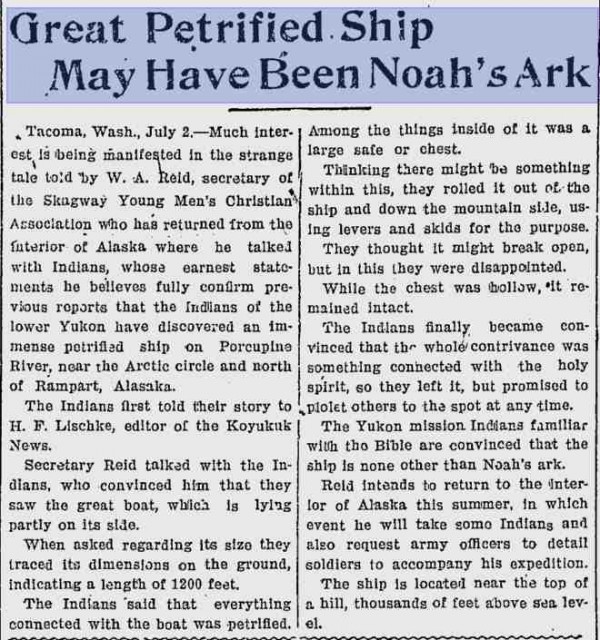
The supposed remnants of Noah's ark have been "discovered" in a wide range of places.
But this 1902 discovery in Rampart, Alaska, on the Porcupine River, seems totally forgotten now.
I wonder if a followup expedition ever was mounted...?
Original article here.
Posted By: Paul - Tue Nov 13, 2012 -
Comments (10)
Category: Oceans and Maritime Pursuits, Regionalism, Religion, Unsolved Mysteries, Myths and Fairytales, 1900s, North America, Native Americans
The Underwater Art of Zarh Pritchard
Zarh H. Pritchard (1866-1956) is a little-remembered artistic pioneer of the 20th century. (There's not even a wikipedia page about him!) His claim to fame is that he was the first artist to paint underwater.Pritchard would descend to the ocean floor in a diving suit and then paint using waterproof paints on a lambskin canvas soaked in oil. An article in the Fort Wayne Journal Gazette (June 18, 1922) provides more details about the process:
His first descent was for a distance of about 65 feet. At the end of about a half an hour cold and fatigue forced him to return to the surface. Later, as he became more adapted to his new environment, he was able to stay longer. He now works at depths varying from 16 to 50 feet. He can work at any depth to which a diver can descend.
When he starts to work he is clad in the customary diving costume with leaded shoes, air hose and signal ropes. He descends slowly through the water and after reconnoitering the territory in which he is going to paint selects a comfortable rock. He then pulls the signal rope and his easel and box of colors are lowered to him. He blocks in his outlines, lays his tints and finishes the picture roughly.
Some of Pritchard's underwater works are below. They sold quite well. The Prince of Monaco, who was a respected oceanographer in addition to being royalty, was a big fan and bought many of them. Read more about Pritchard here.

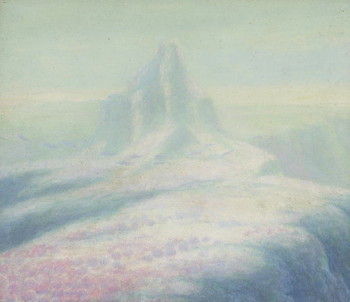


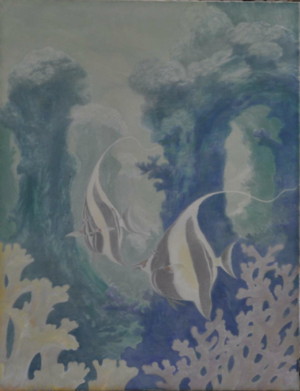

Posted By: Alex - Tue Aug 28, 2012 -
Comments (4)
Category: Art, Oceans and Maritime Pursuits

| Who We Are |
|---|
| Alex Boese Alex is the creator and curator of the Museum of Hoaxes. He's also the author of various weird, non-fiction, science-themed books such as Elephants on Acid and Psychedelic Apes. Paul Di Filippo Paul has been paid to put weird ideas into fictional form for over thirty years, in his career as a noted science fiction writer. He has recently begun blogging on many curious topics with three fellow writers at The Inferior 4+1. Contact Us |





